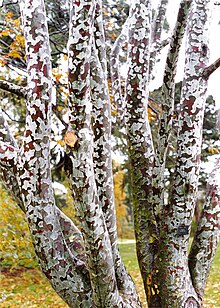Pinus bungeana
| Lacebark pine | |
|---|---|

| |
| Lacebark pine to the east of the Main Hall at Jogyesa (Buddhist Temple) in Seoul, South Korea | |
| Scientific classification | |
| Kingdom: | |
| Division: | |
| Class: | |
| Order: | |
| Family: | |
| Genus: | |
| Species: | P. bungeana
|
| Binomial name | |
| Pinus bungeana | |
Pinus bungeana (English: Bunge's pine[2] or lacebark pine or white-barked pine; Chinese: 白皮松 Japanese: シロマツ, Korean: 백송; RR: baeksong) is a pine tree native to northeastern and central China.[3][4] It is a slow-growing tree that can grow to heights of 15–25m and is frost hardy down to below -26 °C. Its smooth, grey-green bark gradually sheds in round scales to reveal patches of pale yellow, which turn olive-brown, red and purple on exposure to light.


Distribution and habitat
Pinus bungeana is native to mountains of China, but is widely cultivated as an ornamental, especially for its attractive metallic bark.[1] It has naturalized in the Sierra de la Ventana of eastern Argentina.[citation needed]

Uses
It is grown as ornamental tree in far eastern oriental classical gardens where it symbolizes longevity. It can also be seen in botanic gardens and often grows with multiple stems. Its bark is especially admired just after rains because of the emphasised contrasting colours of its peeling plates.

References
- ^ a b Template:IUCN
- ^ NRCS. "Pinus bungeana". PLANTS Database. United States Department of Agriculture (USDA). Retrieved 4 October 2015.
- ^ eFloras, Missouri Botanical Garden & Harvard University Herbaria (FOC Vol. 4 Page 22), Pinus bungeana, retrieved 2009
{{citation}}: Check date values in:|accessdate=and|date=(help) - ^ "The Gymnosperm Database".
Further reading
- Li, B.; W. C. Gu (2002). "A study on phenotypic diversity of seeds and cones characteristics in Pinus bungeana". Biodiversity Science. 10 (2): 181–188.
{{cite journal}}: Unknown parameter|lastauthoramp=ignored (|name-list-style=suggested) (help) - Sujuan, Guo; Ling Hongqin; Li Fenglan. "Physiological and biochemical basis of rooting of Pinus bungeana cuttings". Journal of Beijing Forestry University. 2004 (2).
{{cite journal}}: Unknown parameter|last-author-amp=ignored (|name-list-style=suggested) (help)
External links
- Photo of cone
- Photo of foliage and male (pollen) cones
- Photo of bark
- Gymnosperm Database: Pinus bungeana

